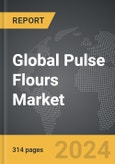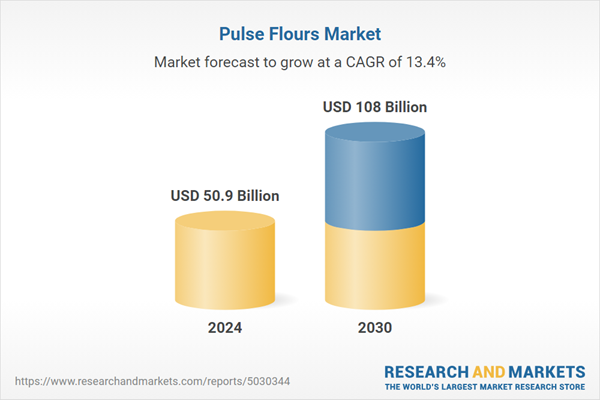The global market for Pulse Flours was valued at US$50.9 Billion in 2024 and is projected to reach US$108.0 Billion by 2030, growing at a CAGR of 13.4% from 2024 to 2030. This comprehensive report provides an in-depth analysis of market trends, drivers, and forecasts, helping you make informed business decisions. The report includes the most recent global tariff developments and how they impact the Pulse Flours market.
Segments: Product (Chickpea, Pea, Lentils, Other Products); Application (Bakery Products & Snacks, Beverages, Other Applications).
Geographic Regions/Countries: World; United States; Canada; Japan; China; Europe (France; Germany; Italy; United Kingdom; Spain; Russia; and Rest of Europe); Asia-Pacific (Australia; India; South Korea; and Rest of Asia-Pacific); Latin America (Argentina; Brazil; Mexico; and Rest of Latin America); Middle East (Iran; Israel; Saudi Arabia; United Arab Emirates; and Rest of Middle East); and Africa.
The analysts continuously track trade developments worldwide, drawing insights from leading global economists and over 200 industry and policy institutions, including think tanks, trade organizations, and national economic advisory bodies. This intelligence is integrated into forecasting models to provide timely, data-driven analysis of emerging risks and opportunities.
Global Pulse Flours Market - Key Trends and Drivers Summarized
Harnessing the Power of Pulses: The Growing Market for Pulse Flours
Pulse flours, derived from legumes such as peas, lentils, chickpeas, and beans, are gaining significant popularity in the food industry due to their nutritional benefits and versatility. These flours are rich in protein, fiber, and essential micronutrients, making them an attractive ingredient for health-conscious consumers and those seeking plant-based protein alternatives. Pulse flours are used in a wide range of food products, including bakery items, snacks, pasta, and gluten-free foods, where they enhance the nutritional profile and provide functional benefits such as improved texture and shelf life. The increasing demand for clean-label, allergen-free, and sustainable food ingredients is driving the adoption of pulse flours, as they align with consumer preferences for natural and minimally processed foods. The versatility of pulse flours in both traditional and innovative food applications is contributing to their growing prominence in the global food market.What Technological Advancements Are Enhancing the Production of Pulse Flours?
Technological advancements are playing a crucial role in enhancing the production and quality of pulse flours, making them more suitable for a variety of food applications. Advanced milling technologies, such as roller milling and air classification, have improved the particle size distribution and functional properties of pulse flours, resulting in better consistency and performance in food products. The development of extrusion and thermal processing techniques has also enhanced the nutritional value and digestibility of pulse flours by reducing anti-nutritional factors such as phytic acid and trypsin inhibitors. Innovations in ingredient processing, such as dehulling and roasting, are improving the flavor and color of pulse flours, making them more appealing for consumer products. Additionally, the use of biotechnology and genetic research is paving the way for the development of pulse varieties with enhanced protein content, improved functional properties, and greater resistance to environmental stresses. These technological advancements are driving the adoption of pulse flours in the food industry by improving their quality, functionality, and nutritional profile.Which Food Sectors Are Driving Demand for Pulse Flours?
The demand for pulse flours is driven by several key sectors within the food industry, including bakery, snacks, pasta, and gluten-free products. The bakery sector is a major consumer of pulse flours, using them to produce high-protein, fiber-rich bread, cookies, and cakes that cater to health-conscious consumers. The snack industry is increasingly incorporating pulse flours into products such as chips, crackers, and extruded snacks, where they provide a nutritious alternative to traditional ingredients like wheat and corn. The pasta industry is also embracing pulse flours, producing gluten-free and high-protein pasta products that appeal to consumers with dietary restrictions and those seeking plant-based protein sources. Additionally, the gluten-free food sector is a significant driver of pulse flour demand, as these flours offer a natural and nutritious alternative to gluten-containing grains. These sectors highlight the diverse applications of pulse flours in meeting the growing demand for healthy, sustainable, and functional food ingredients.What Are the Key Growth Drivers in the Market?
The growth in the pulse flours market is driven by several factors. The increasing consumer demand for plant-based protein and fiber-rich foods is a major driver, as pulse flours offer a nutritious and sustainable alternative to traditional grains and flours. Technological advancements in milling and processing techniques are enhancing the quality, functionality, and nutritional value of pulse flours, making them more attractive for use in a wide range of food products. The rising popularity of gluten-free and allergen-free foods is also boosting demand for pulse flours, as they provide a natural, gluten-free ingredient that aligns with clean-label trends. Additionally, the growing awareness of the environmental benefits of pulses, such as their low carbon footprint and ability to fix nitrogen in the soil, is driving the adoption of pulse flours in the food industry. As consumers and manufacturers continue to prioritize health, sustainability, and innovation, the pulse flours market is expected to experience significant growth.Report Scope
The report analyzes the Pulse Flours market, presented in terms of units. The analysis covers the key segments and geographic regions outlined below.Segments: Product (Chickpea, Pea, Lentils, Other Products); Application (Bakery Products & Snacks, Beverages, Other Applications).
Geographic Regions/Countries: World; United States; Canada; Japan; China; Europe (France; Germany; Italy; United Kingdom; Spain; Russia; and Rest of Europe); Asia-Pacific (Australia; India; South Korea; and Rest of Asia-Pacific); Latin America (Argentina; Brazil; Mexico; and Rest of Latin America); Middle East (Iran; Israel; Saudi Arabia; United Arab Emirates; and Rest of Middle East); and Africa.
Key Insights:
- Market Growth: Understand the significant growth trajectory of the Chickpea segment, which is expected to reach US$45.0 Billion by 2030 with a CAGR of a 14.4%. The Pea segment is also set to grow at 12.5% CAGR over the analysis period.
- Regional Analysis: Gain insights into the U.S. market, valued at $13.3 Billion in 2024, and China, forecasted to grow at an impressive 17.8% CAGR to reach $25.7 Billion by 2030. Discover growth trends in other key regions, including Japan, Canada, Germany, and the Asia-Pacific.
Why You Should Buy This Report:
- Detailed Market Analysis: Access a thorough analysis of the Global Pulse Flours Market, covering all major geographic regions and market segments.
- Competitive Insights: Get an overview of the competitive landscape, including the market presence of major players across different geographies.
- Future Trends and Drivers: Understand the key trends and drivers shaping the future of the Global Pulse Flours Market.
- Actionable Insights: Benefit from actionable insights that can help you identify new revenue opportunities and make strategic business decisions.
Key Questions Answered:
- How is the Global Pulse Flours Market expected to evolve by 2030?
- What are the main drivers and restraints affecting the market?
- Which market segments will grow the most over the forecast period?
- How will market shares for different regions and segments change by 2030?
- Who are the leading players in the market, and what are their prospects?
Report Features:
- Comprehensive Market Data: Independent analysis of annual sales and market forecasts in US$ Million from 2024 to 2030.
- In-Depth Regional Analysis: Detailed insights into key markets, including the U.S., China, Japan, Canada, Europe, Asia-Pacific, Latin America, Middle East, and Africa.
- Company Profiles: Coverage of players such as Anchor Ingredients Co., LLC, Archer Daniels Midland Company, Batory Foods, Inc., Bean Growers Australia Limited, Best Cooking Pulses, Inc. and more.
- Complimentary Updates: Receive free report updates for one year to keep you informed of the latest market developments.
Some of the 24 companies featured in this Pulse Flours market report include:
- Anchor Ingredients Co., LLC
- Archer Daniels Midland Company
- Batory Foods, Inc.
- Bean Growers Australia Limited
- Best Cooking Pulses, Inc.
- Blue Ribbon Products, Inc.
- Diefenbaker Spice & Pulse
- EHL Ltd.
- Great Western Grain Co. Ltd.
- Ingredion, Inc.
- SunOpta, Inc.
- The Scoular Company
Tariff Impact Analysis: Key Insights for 2025
Global tariff negotiations across 180+ countries are reshaping supply chains, costs, and competitiveness. This report reflects the latest developments as of April 2025 and incorporates forward-looking insights into the market outlook.The analysts continuously track trade developments worldwide, drawing insights from leading global economists and over 200 industry and policy institutions, including think tanks, trade organizations, and national economic advisory bodies. This intelligence is integrated into forecasting models to provide timely, data-driven analysis of emerging risks and opportunities.
What’s Included in This Edition:
- Tariff-adjusted market forecasts by region and segment
- Analysis of cost and supply chain implications by sourcing and trade exposure
- Strategic insights into geographic shifts
Buyers receive a free July 2025 update with:
- Finalized tariff impacts and new trade agreement effects
- Updated projections reflecting global sourcing and cost shifts
- Expanded country-specific coverage across the industry
Table of Contents
I. METHODOLOGYII. EXECUTIVE SUMMARY2. FOCUS ON SELECT PLAYERSIII. MARKET ANALYSISSOUTH KOREAREST OF ASIA-PACIFICARGENTINABRAZILMEXICOREST OF LATIN AMERICAIRANISRAELSAUDI ARABIAUNITED ARAB EMIRATESREST OF MIDDLE EASTIV. COMPETITION
1. MARKET OVERVIEW
3. MARKET TRENDS & DRIVERS
4. GLOBAL MARKET PERSPECTIVE
UNITED STATES
CANADA
JAPAN
CHINA
EUROPE
FRANCE
GERMANY
ITALY
UNITED KINGDOM
SPAIN
RUSSIA
REST OF EUROPE
ASIA-PACIFIC
AUSTRALIA
INDIA
LATIN AMERICA
MIDDLE EAST
AFRICA
Companies Mentioned (Partial List)
A selection of companies mentioned in this report includes, but is not limited to:
- Anchor Ingredients Co., LLC
- Archer Daniels Midland Company
- Batory Foods, Inc.
- Bean Growers Australia Limited
- Best Cooking Pulses, Inc.
- Blue Ribbon Products, Inc.
- Diefenbaker Spice & Pulse
- EHL Ltd.
- Great Western Grain Co. Ltd.
- Ingredion, Inc.
- SunOpta, Inc.
- The Scoular Company
Table Information
| Report Attribute | Details |
|---|---|
| No. of Pages | 314 |
| Published | April 2025 |
| Forecast Period | 2024 - 2030 |
| Estimated Market Value ( USD | $ 50.9 Billion |
| Forecasted Market Value ( USD | $ 108 Billion |
| Compound Annual Growth Rate | 13.4% |
| Regions Covered | Global |









